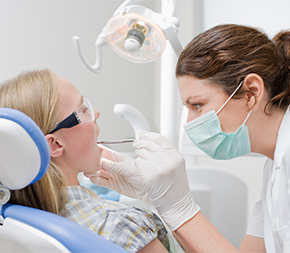In this Article

Median Annual Salary
According to the U.S. Bureau of Labor Statistics (BLS), the annual median salary for a dental assistant is $46,540. But there are many factors that can affect your salary, including where you live.
Salaries for dental assistants can vary significantly by state and metro area. The highest salaries for dental assistants are spread across the country and are likely to be in states that have shortages of qualified dental assistants. You may also find higher-than-average salaries in states where there is increased demand for dental services due to a higher concentration of older adults.
Dental assistant is an in-demand allied health position that includes both clinical and administrative duties. It’s also a growing profession with plenty of opportunities for growth.
Highest-Paying Cities for Dental Assistants
A shortage of qualified dental assistants and a high cost of living can often inflate wages in a city or region. The 10 highest-paying metropolitan areas are spread from coast to coast in the U.S., indicating a widespread demand for dental assistants.
Dental Assistant Salary Comparison
The educational pathway to become a dental assistant is similar to other allied health professions.
Compare the following salaries, based on BLS figures, for allied health positions that require a certificate/diploma for entry-level roles.
What Factors Can Affect Your Salary?
The salary you earn as a dental assistant can vary based on your location, education, experience, professional certifications, and other factors. The BLS reports that the top 10% of dental assistants earn annual median salaries of $61,060. Consider how these factors can affect your earning potential in this role:
Geography
Like all professions, the salary you earn can differ from one part of the country to another. In some cases, you may not have to go far to increase your pay. Salaries can often vary between two metropolitan areas in the same state.
Areas in which there are growing numbers of older adults may have a higher demand since people tend to require more complex dental care and treatment as they age.
Education
There are several educational pathways to becoming a dental assistant. You can earn the skills and knowledge you need by completing a certificate/diploma program or an associate degree. In some states, you may be able to begin working without a formal education and learn your skills on the job.
However, a formal education from an accredited dental assisting program can help you qualify for a professional certification, a credential that can increase your job opportunities.
Employers usually prefer to hire a certified, educated dental assistant to one who will be “on-the-job trained” (OJT) because the certified assistant is coming to the job with basic dental knowledge, says Susan D. Bentley-Camizzi, CDA, BSDH, MSEd, president-elect of the American Dental Assistants Association (ADAA).
Certifications
A certification helps prove you’ve demonstrated mastery of the knowledge and skills necessary to perform specific tasks. It also tells others that you’re committed to your career and the quality of service you provide.
A formal education from an accredited dental assisting program can help you qualify for a professional certification, a credential that can increase your job opportunities.
Dental assistants who hold the national Certified Dental Assistant (CDA) credential have the potential to earn more.
The Dental Assisting National Board Inc. (DANB) offers this credential and all others for dental assistants. The DANB says that according to its 2020-2022 Dental Assistants Salary and Satisfaction Survey, dental assistants who have a CDA earn about $2 more an hour than the BLS median salary.
Certification by the DANB is recognized by or required in 37 states, the District of Columbia, the U.S. Air Force, and the Department of Veterans Affairs.
“Dental assistants who are considering working in another state in the future may be more likely to meet their new state’s requirements if they hold DANB certification,” says Hanna Aronovich, chief marketing and communications officer with the DANB and the Dental Advancement through Learning and Education (DALE) Foundation.
Workplaces
Your employer and workplace can play a role in how much you earn because your responsibilities can vary significantly based on factors such as the type and size of your employer.
While a dental assistant typically performs a variety of roles related to patient education, care, and dental health, there are many other potential duties that can come with a job. Consider a job’s responsibilities, along with the education, certification, and experience you bring to an employer when comparing your salary against national averages and other factors.
Job Outlook for Dental Assistants
Demand for dental assistants is expected to grow across the country and most notably where there is an increasing number of older Americans, the BLS says. Thus job stability is considered one of the reasons to pursue becoming a dental hygienist.
According to the U.S. Census Bureau, the number of baby boomers aged 65 and over will increase by 10,000 every day through 2030, when all baby boomers will be at least 65 years old. Individuals at this age and beyond are more likely to need complicated dental procedures, increasing the need for qualified dental assistants and other dental providers.
Across all ages, the demand for preventive dental care is also likely to grow as more data links a person’s oral health to their overall health, the BLS says. Poor oral health, especially gum disease, has been linked to conditions including heart disease, diabetes, and stroke.
Demand for Dental Assistants
With job growth projected at through 2032, there will be 30,100 more dental assisting jobs to fill. While it’s difficult to predict exactly where these new positions will be, consider the current geographic and industry distribution of dental assistants to see where they’re in demand now.
The metro areas with the highest demand for dental assistants rank among the most populous.
How to Boost Your Salary as a Dental Assistant
Earning national certification is one of the best ways to boost your salary from the start of your dental assisting career. According to the DANB, dental assistants who hold the DANB’s CDA certification are likely to earn more than the national median reported by the BLS.
Other ways you may be able to boost your salary include:
Additional Education
It’s never too late to return to the classroom, whether virtually or on-site, and dental assistants have many opportunities to grow professionally through education programs.
You can return to school to get the education you need to earn your CDA certification or increase your duties as an expanded function dental assistant. You can also use a formal dental assisting education as the foundation to earn an associate degree in dental hygiene or another higher-paying allied health profession. The annual mean salary for dental hygienists is $87,530, according to the BLS.
Specialty Certification
After earning your CDA, you can expand your skills and career options with specialty certifications. Earning one of these certifications can make you more marketable to potential employers who serve patients within your specialty.
Aronovich says it’s common for certified dental assistants to move on to specialty certifications such:
She says dental assistants who want to stay on the cutting edge of specialization can consider to two new certifications offered by the DANB and the Organization for Safety, Asepsis, and Prevention (OSAP):

Written and reported by:
Anna Giorgi
Contributing Writer

With professional insight from:
Susan D. Bentley-Camizzi, CDA, BSDH, MSEd
American Dental Assistants Association, President-Elect
Infection Control Monitor, School of Dental Medicine, University at Buffalo
Dental Assisting Program Director, Retired

Hanna Aronovich
Chief Marketing and Communications Officer
Dental Assisting Board and the DALE Foundation